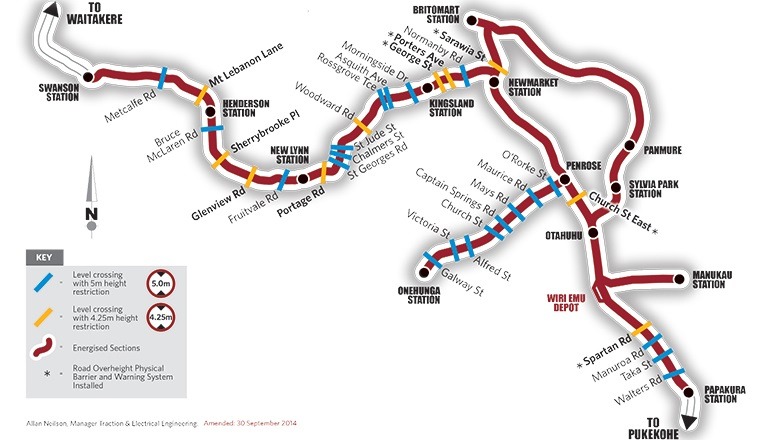Auckland’s new electric rail infrastructure brings a more efficient service to commuters, but the new 24kV AC overhead power lines are also safety risks to contractors working near the rail corridor. LAWRENCE SCHAFFLER reports.
SOME SEVEN YEARS AFTER it began, the $600 million Auckland Electrification Project (AEP) was completed in September this year. Designed to improve the lives of rail commuters around Auckland (particularly with a faster, more frequent service), the electrified network now extends from Papakura in the south to Swanson in the west, and includes the Onehunga Branch Line and Manukau Rail Link.
 Building it involved a significant upgrade to the rail corridor itself – the installation of 3500 foundations and masts carrying 560 kilometres of overhead lines across 175 kilometres of railway track. It also required the rebuilding of several road bridges across the tracks to allow room for the new power lines underneath. Other infrastructure upgrades included new signalling and improvements to network technology.
Building it involved a significant upgrade to the rail corridor itself – the installation of 3500 foundations and masts carrying 560 kilometres of overhead lines across 175 kilometres of railway track. It also required the rebuilding of several road bridges across the tracks to allow room for the new power lines underneath. Other infrastructure upgrades included new signalling and improvements to network technology.
Urban design was also factored into the project – sleek conductor beams in Britomart (rather than overhead wires) minimise clutter inside this character building, and overbridges are fitted with unobtrusive safety barriers. Both mitigate the impact of new infrastructure. Specifically formed for the project, the Hilor consortium carried out the construction. It was led by Hawkins and the Australian company Laing O’Rourke, with Fulton Hogan, Seimens and others involved at a sub-contractor level. A fundamental feature of the project was that the vast majority of work had to be tackled without disruption to the rail network. This meant night shifts and weekend work predominantly.
The first of the trains (purchased from Spain) began running in April this year on the Onehunga Line – the entire complement of 57 trains is expected to be operational by July next year. Replacing Auckland’s diesel commuter rail fleet, each train comprises three cars carrying up to 232 seated passengers.
Maximum operating speed is 110km/hr, though the average operating speed will be less. Energy efficiency benefits derive from each train being quipped with regenerative braking. This sees energy produced by the train being fed back into the 25kV supply – a recovery of up to 20 percent of the energy used.
Safety issues
Electric trains are also much quieter than their diesel-powered predecessors – an important consideration, says KiwiRail, for people using level crossings or those living and working near the rail network. Contracting crews, in particular, need be stay alert when working near the rail corridor.
The introduction of overhead power lines has resulted in height restrictions for some road users at level crossings (there are 31 level crossings within the newly-electrified Auckland area). At most level crossings the height restriction is five metres, but 11 have a reduced height restriction of 4.25 metres. New roadside signs warn drivers about the power lines and display the height restriction at such level crossings.
Note that the electricity flowing through the overhead wires (24kV AC) can “arc” or “jump” to anything that gets too close to it. This can be exacerbated by stray steam or water (often prevalent when waterblasting).
Pre-planning
Anyone planning to undertake building, construction or maintenance activity alongside the rail corridor (within 10 metres of the railway tracks and their overhead wires) should contact KiwiRail. They may require a special permit. Call 0800 801 070 or email kiwirail@kiwirail.co.nz to find out how the work can be done safely.

Road users wanting to cross a level crossing with loads higher than the sign-posted clearances will need to obtain written permission from KiwiRail. This can be obtained by contacting KiwiRail Operations Support desk on 04 474 2323 or email crossingpermits@kiwirail.co.nz
KiwiRail will carry out regular inspections of the rail corridor to ensure no vegetation is growing too close to the wires.
People living next to the newly-electrified rail corridor are advised to maintain a minimum distance of four metres from the wires at all times. They should be mindful of the proximity to wires when moving tall objects such as ladders and poles near their boundary.
The company has also taken significant steps to improve the safety surrounding the new trains themselves – newly-installed technology provides greater levels of automation and communications across the network.
An automated signalling system, for example, allows bidirectional operation and Automatic Route Setting, which enables Train Control to optimise train movements around the network and minimise delays to services.
In addition, an automatic override train protection system activates if drivers are travelling too fast towards red lights or exceed the speed limits incorporated into the network. Further safety measures include a SCADA control system and an upgrade to KiwiRail’s Traction Control Centre in Wellington.

